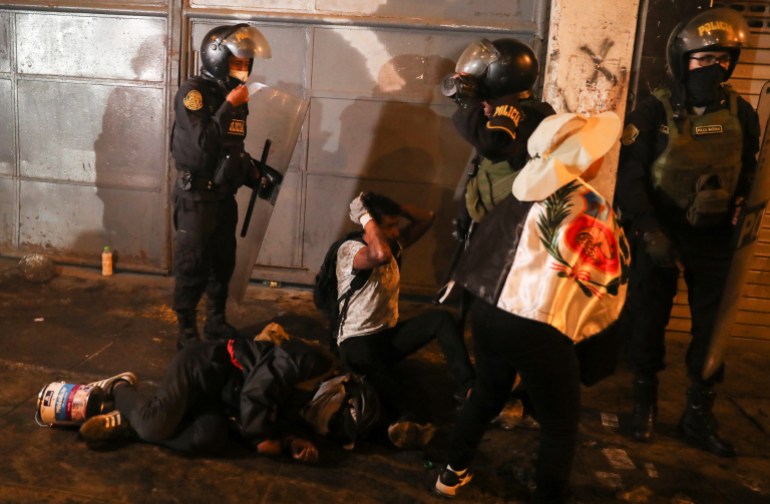Police officers used tear gas to repel demonstrators as protests continue after the removal of President Castillo last month.
Dozens of Peruvians have been injured after tensions spilled into the streets once again in the ongoing anti-government demonstrations since the removal of Pedro Castillo as president.
In the capital Lima on Friday, police officers used tear gas to push back demonstrators throwing glass bottles and stones, as fires burned in the streets, local TV footage showed.
By late afternoon, 58 people had been injured across the country in demonstrations, according to a report from Peru’s ombudsman.
In the country’s southern Puno region, some 1,500 protesters attacked a police station in the town of Ilave, Interior Minister Vicente Romero said in a statement. A police station in Zepita, Puno, was also on fire, Romero said.

The unrest followed a day of turmoil on Thursday, when one of Lima’s most historic buildings burned to the ground, as President Dina Boluarte promised to get tougher on “vandals”.
The destruction of the building, a near-century-old mansion in central Lima, was described by officials as the loss of a “monumental asset”.
It came after thousands of protesters descended on the city earlier this week calling for change and angered by the protests’ mounting death toll, which rose to 45 on Thursday.
Journalist Mariana Sanchez, reporting from Lima, said demonstrators wanted human rights organisations to look into the deaths and those responsible.
“For now, the protesters say they will stay on the streets no matter and until [President] Dina Boluarte resigns,” she told Al Jazeera.
However, Boluarte has dismissed calls for her to resign and hold snap elections, instead calling for dialogue and promising to punish those involved in the unrest.
Ongoing demonstrations
Protests have rocked Peru since Castillo was removed in December after he attempted to dissolve the legislature to prevent an impeachment vote.
Castillo, a political novice who lived in a two-storey adobe home in the Andean highlands, eked out a narrow victory in elections in 2021 that rocked Peru’s political establishment and laid bare the deep divisions between residents of the capital and the long-neglected countryside.
The unrest, caused by his removal, has been largely concentrated in Peru’s south.

In the Cusco region, Glencore’s major Antapaccay copper mine suspended operations on Friday after protesters attacked the premises – one of the largest in the country – for the third time this month.
Airports in Arequipa, Cusco and the southern city of Juliaca were also attacked by demonstrators this week, delivering a blow to Peru’s tourism industry.
“It’s nationwide chaos, you can’t live like this. We are in a terrible uncertainty, the economy, vandalism,” Lima resident Leonardo Rojas told Reuters news agency.
The government has extended a state of emergency to six regions, curtailing some civil rights.
Human rights groups have accused the police and army of using deadly firearms. The police say protesters have used weapons and homemade explosives.


